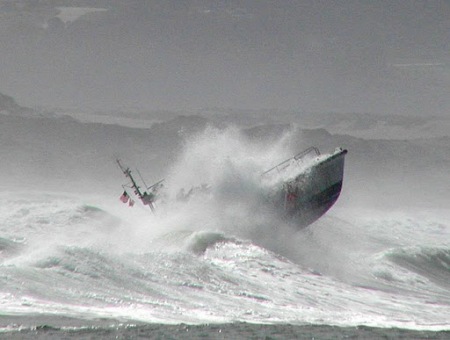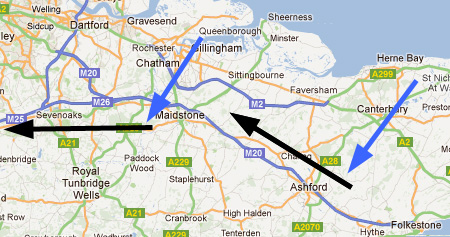Riding in strong wind gusts
I was a keen sailor, navigating a 32 foot yacht in diverse weather conditions, and all nautical aspects as navigation, weather and wind were of great interest, and sometimes concern.
Since riding my more naked Harley-Davidosn Road King, the feeling of navigating the wide oceans is back, at least when not in the middle of a bloody congestion. Recently, on a ride back from the Eurotunnel to London, this feeling was again very pronounced. Very heavy rain fell from the skies, and the gale force winds made riding on the M20 a challenge, as strong wind gusts hit the bike repeatedly. If sailor or bike rider, the rain gear should be similar, and the way the bike or yacht suddenly leans over is as scary as exciting. But the feeling of still being able to stay on course is intoxicating. You do not fight nature, you find a way to allow survival, as nature is always stronger.
The knowledge of true and apparent wind came very helpful. Unfortunately, when discussing the weather, most riders just ask: will it rain or not, though this is the least important factor. Wind strength on the other hand is important, and here even more: the wind direction.

Some thoughts on wind strength. There are numerous scales and units: Beaufort scale, knots (nautical) and mph. We all can feel strong winds, and usually stay home when the umbrella gets blown into pieces. But its all about perception. Take Beaufort 8, a fresh gale where most holiday sailors will wisely stay in harbour if they can. It has constant winds up to 40 knots, and thats 46mph. Now every Fatboy rider will know the wind blowing into his face at speeds of 46mph, and he will surely say: sustainable for hours. But between the sailor and bike rider there are 2 big differences: a) on a bike the front wind created by speed is pretty constant, and more importantly b) the road does not form high wave that make many of us sick.
But ask the Fatboy guy how he feels at 115 mph? He may say: never go that fast, but actually, last Saturday he “apparently” did just that. If you stand still, you feel the true wind, but if you move, you feel the apparent wind, and it is coming out of a different direction. If the true wind comes straight from where you go, you can just add the two speeds to calculate the apparent wind force. If the wind comes from behind, you just deduct it. But these 2 cases are rare occasion, as wind turns as do the roads. So you are riding in a constant changing environment, and not only does the wind direction change, but also its strength, and these are called gusts of wind. Even in a comfortable strong breeze (Beaufort 5-6) peaks can reach 50 mph, doubling in the fraction of a second. It hist you unannounced and unprepared, and the struggle to keep the bike on course starts as quickly as it is over again.
Remember one thing: wind strength and direction are critical, and adding these parameters to your own bike speed will determine what you feel, how strong you get pushed sideways and what you have to deal with.
In the above drawing I looked at 3 scenarios, as they all happened last Saturday. Bike speed 75 mph, wind gusts of 50 mph (thats a lot!) result in apparent wind ranging from 55 mph to 115 mph. The scary part, the one you can prepare yourself for, is that you feel like accelerating in the fraction of a second from 55mph to 115 mph, while being pushed to the side. Not even a Ferrari offers you this kind of sudden acceleration, its torque at its finest. But actually, your bike did not accelerate, the wind direction changed.
If you look at the ride last Saturday, the theory confirms what happened on the road: conditions were nasty between Ashford and Maidstone, and became better later on the M26/M25. Nothing actually changed, except the riding direction, and it made a big difference in handling the bike. The true wind turned backwards, coming more from behind, reducing the apparent wind strength and angle of attack, as it moved forward, feeling like coming from the front, something your bike is used and designed for.
For those few of you who want to do the exact math, please find the formulas below. For me its easier to visualise the little black, blue and red arrows, and you can judge what potentially to expect. With the understanding of where I go nautically, and the knowledge of direction and expected strength of the true wind and resulting apparent wind, I can not avoid the nasty gust of winds, but am the little fraction of a second better prepared, the surprise factor is reduced or even gone, and my chances to stay in the chosen lane increase.
I hope you sail the roads safely.





April 29, 2012 at 6:52 pm
Way too complex for my little brain, but what I do know is it was bloody windy recently! We were meant to get a ferry from northern Spain a week ago and missed it because we were too late. Lucky for us, as we found out the ferry was caught in a Force 10 gale in the Bay of Biscay.
I hate riding in very strong winds, especially on motorways where you also need to adjust for bridge abutments and lorries, as both have a great influence on the wind.
April 29, 2012 at 6:33 pm
Yes a mathematical description of the vector forces. In simple terms as I followed Axel home up the M20/M26 he was definitely travelling East whilst the bike was pointing EastNorthEast. Frankly I had enough on my mind staying on the road to be pondering such academic issues 🙂 T
April 29, 2012 at 2:03 pm
Take a country road, much more enjoyable 🙂
April 29, 2012 at 2:21 pm
Good article. Personally the winds I find most tiring to navigate are those quartering headwinds that can sweep from side to side in an instant blowing you first one way and then the other. They’re truly nasty!